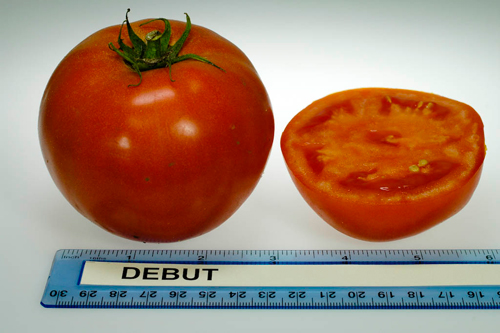Tomato variety Debut (F1)
The Dutch company Monsanto Holland B. V., quite well-known in our market, has pleased experienced and novice vegetable growers with an excellent variety called Debut. The application for registration of the novelty was submitted in 2007, the inclusion in the State Register of Breeding Achievements of Russia took place a year later. All regions of the country are suitable for cultivation. The tomato is recommended for open ground and film shelters of personal subsidiary plots. I would like to note that due to its low stature, it is excellent for growing even under low shelters. It is a hybrid, therefore it is labeled F1.

Description
The plant belongs to determinant, medium-sized, compact bush, 60 - 65 cm high. When grown indoors, you need to be prepared for the fact that the growth will be slightly larger. The root system of the variety is very powerful, providing the crop with the necessary moisture and nutrition for growth and development. Shoot formation in tomato is not too high, leafiness is moderate. Leaves of medium size, usual type, with a slightly wrinkled surface, dark green in color. The inflorescence is of an intermediate type. In each cluster, up to 5 fruits are generally formed. The peduncle is articulated.
Outwardly, the fruits of the Debut look just great. Flat-rounded or rounded, with slight ribbing at the peduncle, thick-walled and dense. The skin is thin, but firm, glossy. An unripe tomato of a light green hue, without a spot at the stalk, when ripe becomes a rich red color. The pulp is fleshy, dense, holds its shape well when cutting, multi-chamber. Seed nests, although numerous, 6 or more, are small in size. The taste is good and excellent. Tomatoes are large-fruited. Fruit weight, according to the State Register, is 210 - 230 grams. The originator claims from 200 to 220 grams. In warm regions, subject to agricultural technology, it is possible to grow specimens of 300 - 400 grams.

Variety characteristics
- Hybrid Debut favorably with early maturity. From the moment of emergence of full shoots to the beginning of ripening, it takes about 90 days. Fruit picking can be done 57 - 60 days after transplanting;
- the yield of marketable fruits, according to the State Register, is 9.1 kg per 1 square meter. According to other sources, up to 4.5 kg of selected tomatoes can be removed from one bush;
- the originators note the excellent adaptability of the plant, capable of withstanding temperature extremes. The variety is especially resistant to low temperatures;
- excellent marketability of tomatoes is noted, they are resistant to cracking, even at high humidity;
- the culture's immunity is quite high. The debut perfectly resists the tobacco mosaic virus, fusarium wilting, alternaria stem cancer, gray leaf spot;
- long-term transportation of the fruits is excellent, due to the dense structure and strong skin. Subject to storage standards, shelf life can be up to a month or one and a half;
- the way of eating tomatoes is universal. Early ripe tomatoes are a great way to replenish your vitamin supply. They are also used for salting, making tomato paste, juices, mashed potatoes.
Agrotechnics
Growing an early variety is, of course, best done in seedlings. It is advisable to calculate the timing of Debut planting yourself, taking into account the climatic features of the region. The age of seedlings ready for transplantation will be 50 - 55 days. At this point, the seedlings must go through the process of picking and hardening. Despite its small size, the plant requires a garter to a support and partial pinching, that is, the removal of shoots to the first brush. The care is indistinguishable from the culture as a whole.The soil should be moderately moist. For feeding tomatoes, universal fertilizers are used.
Hybrid Debut has proven itself well due to the combination of large-fruited and yield. An unpretentious and disease-resistant variety will not take much time during cultivation, but in the end, even an inexperienced tomato grower can get a good result. Our hero has no particular disadvantages, except for the need for tying and partial pinning. The only disadvantage is the need for the annual purchase of seeds.








